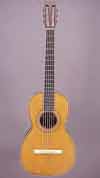 |
Here's the patient, a Martin guitar, style 21/2-40,
made in 1887.
According to its last owner, this instrument had been carried through equatorial
Africa during the 1960s by a missionary who had it set up with steel strings. Considering
its age and treatment, its survival is a testimony to good workmanship and the quality
of well fitted hide glue joinery.
This and the next two photos are "after" shots, because I don't have any
full pictures of the damaged guitar. |
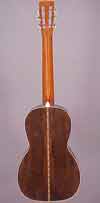 |
The back and sides are of Brazilian rosewood, the top is spruce, and
the neck is Spanish cedar - all typical materials for Martin instruments of this
period.
The white binding, heel cap, tuner buttons, nut, bridge, bridge pins and saddle are
all original, and made of elephant ivory. Although synthetic ivory (ivory grained
celluloid, or "ivoroid") was available for instruments in 1887, Martin
continued using ivory for bindings until around 1920. |
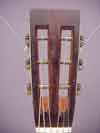 |
Typical of the period - the plain slotted peghead with no company
logo. On the back of the peghead is a simple stamping that reads: "C. F. Martin,
New York." This vintage guitar is often called a "New York Martin"
but like all Martin guitars after 1839, was made in Nazareth, Pennsylvania. (Martin's
sales agency remained in New York until the turn of the century.) |
 |
The back of the peghead had been smashed, and although the glue joints
held well, the wood was badly broken in the area. |
 |
The bridge had become loose a while ago, and I suppose it laid around
unnoticed with the strings up to full tension. |
 |
Because of the long term "over-stringing" with steel strings
and the loose bridge, the top had become terribly distorted and showed a very large
bulge behind the bridge. Notice also, the shrinkage cracks in the top which resulted
from exposure to heat and low humidity. |
 |
I started the job by loosening the "tongue" of the fingerboard
over the body, and removing the 15th fret to allow access for my steam needle. I
drilled a 1/16" hole for the steam needle, right through the fret slot into
the cavity at the end of the dovetail joint. |
 |
In the background you can see my steam generator, an old expresso
milk steamer. These things work well for loosening old dovetail joints. |
 |
As you can see, the joint came apart well with relatively little steam
damage to the surrounding finish. |
 |
Turning my attention to the other end of the neck, I spent the better
part of a day with a water pipette and palette knife slowly "teasing" the
old hide glue peghead joint apart. |
 |
It was a tedious process, but I didn't want to use heat for fear of
damaging the original shellac finish which was in reasonably good shape. |
 |
Here, I've gotten the original joint disassembled, and I'm beginning
to get the old crack open. |
 |
I used deionized water, because it's effective in cleaning
old dirt without adding any contamination that might impair the adhesion of my new
hide glue. Naturally, I used hot hide glue exclusively for this restoration, because
the instrument was made with it, so that's what future repairers would expect to
encounter. |
 |
Here's the last broken flake coming off the old joint. |
 |
Rather than simply reglue the entire joint and broken pieces all at
once, I chose to rebuild the joint to photograph it for Richard Johnston's book |
 |
So here it is. The famous "diamond" or "dart"
that you see on the back of the peghead of many Martin guitars. Originally, this
little carving was a reinforcement for the jointed peghead. |
 |
Julius Borges, maker of the fine Schoenberg guitars, tells me this
is is a modified "bridle joint." |
 |
Any way you look at it, this is a fine piece of joinery. Martin hasn't
used this joint since about World War I, but still they carve a vestigial tribute
on the back of the neck of every D-28, and many other models. |
 |
I could have easily damaged that fragile little finger when I clamp
the joint back together, so I got out my Quick Carve. It's a fast setting catalyzed
compound used for pattern making. |
 |
Protecting the neck with plastic film, I squished a bit of Quick Carve
onto the area, and backed it with a piece of Masonite. |
 |
That gave me a perfect molded clamping caul so I could safely glue
things back together. |
 |
Here's the peghead joint all clamped up. |
 |
And all finished, with the tuners back in place. |
 |
Back to the water and palette knife for some more tedium. It took
a long while to get that old ivory binding off! |
 |
Prying the back loose went smoothly, and I could hear the familiar
crackle of the hide glue as the lining joints broke apart. |
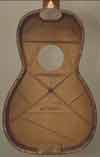 |
No doubt about the age of this guitar. The shop foreman did us a favor
by dating the inside of the top. Such top dating was customary for Martin through
most of the 1880s and all of the 1890s. I only wish they'd started the practice earlier!
All the top bracing was still tightly glued in place, and everything looked in good
order, except for that distorted bridge area. |
 |
Speaking of which, take a look at the shape of the top. Pretty bad
warping around that poor old bridge. |
 |
I heated and pried off the bridge plate to discover that the top was
broken completely through across the grain in front of full length of the bridge,
through some of the bridge pin holes, and partly through the back of the bridge.
The bridge itself basically fell off when I removed the strings. |
 |
I moistened the top and clamped it to a flat plate, with lots of clamps
and heavy interior cauls. I simply set it aside for a few weeks to help flatten it
out. |
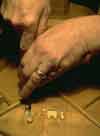 |
Returning to the job, I started to prepare the area for rebuilding.
Taking my 1/2" wide bent chisel, I carved away the top in the area of the cross
grain cracks. |
 |
Using my smallest flat "finger plane" I created "ramps"
in front and behind the bridge. |
 |
By now, the entire area covered by the bridge had been removed from
the inside, and the ramps were complete. |
 |
I took the time to plane the top to a thin razor edge, so my new top
material would lay in right up under the bridge. |
 |
To get the best new top repair material, I split my own billet of
spruce. With literally no runout, it had the maximum grain strength. |
 |
I measured the top and made my new patch material just the same thickness. |
 |
"Chalk-fitting" is the traditional method of getting a good
match. I fitted, tried, carved, refitted, retried, and recarved until my new patch
fit right in. |



































